X Marks the 🍎
This puzzle consists of four minipuzzles, each about a different type of tree. Each minipuzzle is named after an actual tree species and solves to a single-word answer. The solutions to the minipuzzles follow:
Peach Tree (Family Trees)
Each image corresponds to the family tree of a family that is the main subject of a television show. As is typical of pedigree charts, women are depicted with circles and men are depicted with squares. Horizontal dashed lines are used to indicate divorced or separated couples and vertical dashed lines indicate adoptions.
The first letters of the names of the TV shows are shown below the family tree images to aid in identification. These are sorted alphabetically. The family trees are sorted by the air date of their TV show’s premiere.
In each family tree, one individual’s symbol is shaded green:
| Air Year | Television Show | Family | Character shown in green |
|---|---|---|---|
| 2003 | Arrested Development | The Bluths | Lindsay Bluth (Fünke) |
| 2009 | Modern Family | The Pritchetts | Alex Dunphy |
| 2010 | Downton Abbey | The Crawleys | Edith Pelham |
| 2016 | The Crown | The British Royal Family | Wallis Simpson |
| 2018 | Succession | The Roys | Marcia Roy |
| 2022 | House of the Dragon | The Targaryens | Daemon Targaryen |
The marked individuals, when sorted alphabetically, match the enumerations given at the bottom. Reading the letters corresponding to the numbered blanks in order yields the answer: SIDNEY.
European Beech (Binary Tree)
We’re given an incomplete binary tree in which some nodes are marked with letters. There are 26 nodes, not counting the tree’s root. The key insight is that this tree represents the morse code encoding of the alphabet: starting at the root node, each branch represents either a dot or a dash.
The given four letters is enough to determine the identity of all 26 nodes:
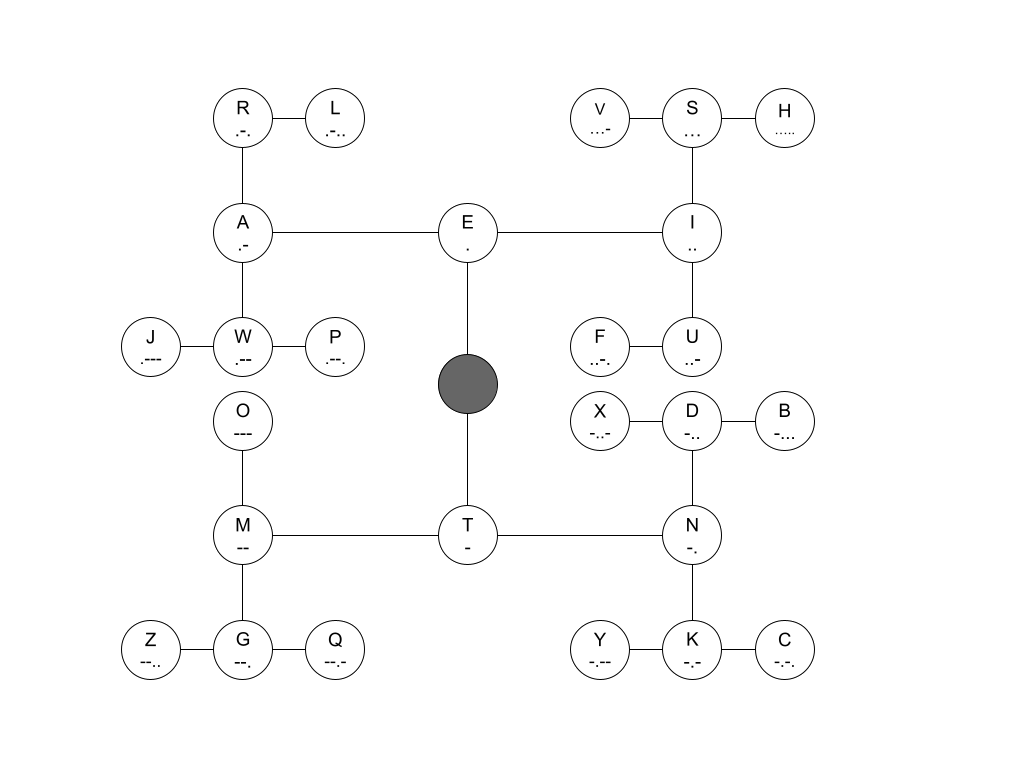
The four numbered nodes spell MAIN in order, the answer to this minipuzzle.
Sugar Maple (State Trees)
Each of the five “tree” shapes is composed of distinct shapes. Each shape is either a full state, the western half of a state, or the eastern half of a state. If we convert each state present into its two letter abbreviation, taking the first letter if the shape is the western half, the second letter if the shape is the the eastern half and both letters if the full state shape is present, we get the following:
| # | Eastern Half | Western Half | Full States | Letters |
|---|---|---|---|---|
| 1 | DE, MN | PA, CO, AL | (none) | ENPCA |
| 2 | ME | LA, NY | CA, ND, UT | ELNCANDUT |
| 3 | ME, DE, VT | WV, SC, RI, TX, PA | NE, NE, WI, HI | EETWSRTPNENEWIHI |
| 4 | OR, NE, ID, IL, DE | PA | MA | REDLEPMA |
| 5 | MO, WY, FL | AZ, LA | ME, RI, CA, NH | OYLALMERICANH |
Each of the sets of letters can be unscrambled to form a tree species. Each species is the state tree of one unique US state:
| ENPCA | PECAN | Texas |
| ELNCANDUT | CANDLENUT | Hawaii |
| EETWSRTPNENEWIHI | WESTERN WHITE PINE | Idaho |
| REDLEPMA | RED MAPLE | Rhode Island |
| OYLALMERICANH | AMERICAN HOLLY | Delaware |
Taking the first letters of the states yields the answer to this minipuzzle: THIRD.
Red Maple (Phylogenetic Tree)
The diagram presented is a phylogenetic tree, specifically a cladogram. Each of the species of the characters presented below the diagram can be placed in the cladogram based on its evolutionary history:

Indexing the number in the original diagram into the character’s name, and reading left to right in the diagram yields the answer to the minipuzzle: AMESBURY.
| Horse | BOJACK HORSEMAN | 4 | A |
| Cat | TOM | 3 | M |
| Coyote | COYOTE | 11 | E |
| Dog | SCUD | 1 | S |
| Human | BELLE | 1 | B |
| Monkey | CURIOUS GEORGE | 6 | U |
| Mouse | JERRY | 3 | R |
| Platypus | PERRY THE PLATYPUS | 5 | Y |
(Note that the characters were presented alphabetically by name.)
Apple Tree (Meta)
Each minipuzzle’s answer is a street name in Cambridge, MA.
| Tree Species | Type of Tree | Answer | Cambridge Street |
|---|---|---|---|
| Peach Tree | Family Trees | SIDNEY | Sidney St. |
| European Beech | Binary Tree | MAIN | Main St. |
| Sugar Maple | State Trees | THIRD | Third St. |
| Red Maple | Phylogenetic Tree | AMESBURY | Amesbury St. |
The city of Cambridge maintains a map of all trees planted on public property; it turns out that along each street there is exactly one cluster of trees of the corresponding species. We can use the information at the bottom of the puzzle to pinpoint a specific geographic location near each cluster of trees.
| Peach Tree | “Halfway between the two of them” | 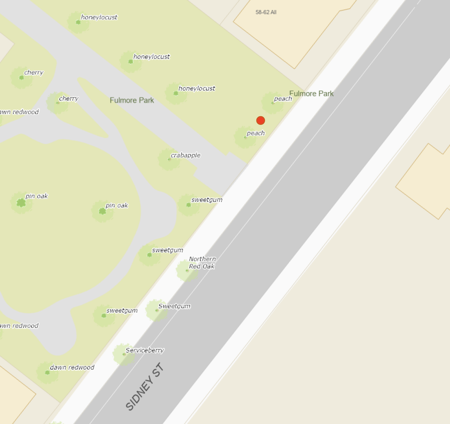 |
| European Beech | “Halfway between the two of them” | 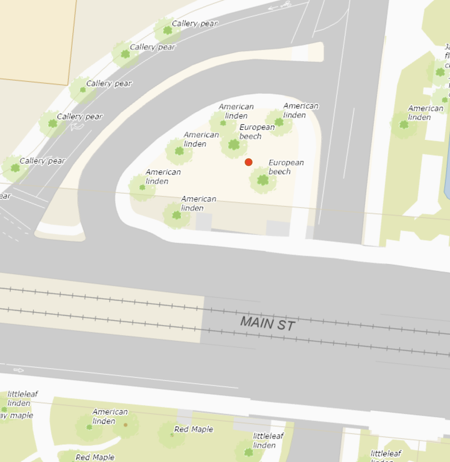 |
| Sugar Maple | “40 ft north of the southmost of the three” | 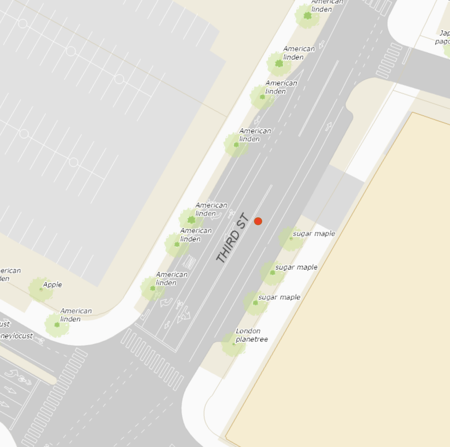 |
| Red Maple | “40 ft north of the only one” | 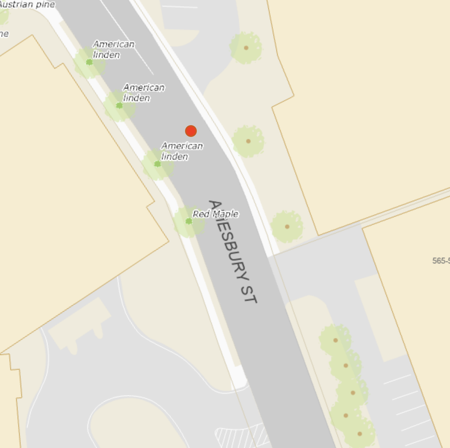 |
As the title suggests, we should treat each geographic location as the point of an ‘X’ and find the intersection point (connecting Peach Tree to European Beech and Sugar Maple to Red Maple).
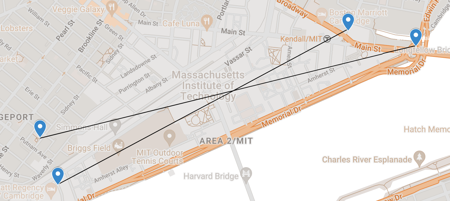
The intersection point lies just southwest of MIT’s Great Dome, within an outdoor space known as the President’s Courtyard:
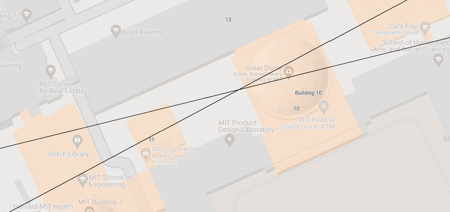
We must visit the courtyard, looking for (as the title suggests) an apple tree. We will eventually find a tree with a large red plastic apple hanging by a string from a branch. The apple can be opened, and inside are several identical rolled up pieces of paper with a final puzzle:
Find my siblings!
|
A plaque under the tree provides a clue as to the solution: this particular tree is in fact a real apple tree and is a descendent of the legendary tree that inspired Newton to come up with the theory of gravitation. It was gifted to MIT in 1942.
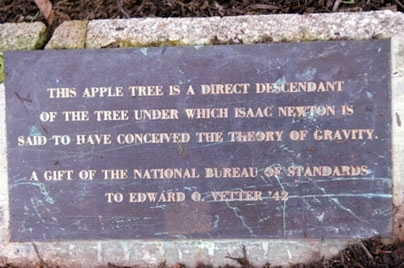
There are several similarly-descended apple trees in various universities and gardens around the world. Each city/state/province given in the puzzle corresponds to the location of one such tree. The specific name of the institute housing the tree fits in the provided enumeration:
| Melbourne | MONASH UNIVERSITY | O |
| Tennessee | VANDERBILT UNIVERSITY | V |
| Kent | EAST MALLING RESEARCH STATION | E |
| Western Cape | BABYLONSTOREN | R |
| Buenos Aires | CENTRO ATÓMICO CONSTITUYENTES | A |
| Bunkyō | KOISHIKAWA KŌRAKUEN | R |
| Vancouver | TRIUMF | M |
Taking the letters placed in blanks with an X in order spells the final answer: OVERARM.